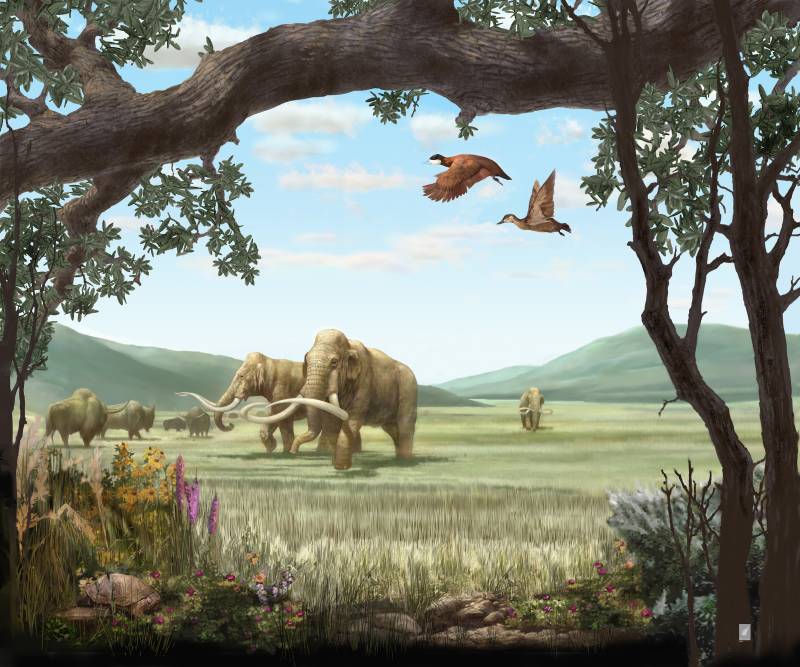By contrast, the Bay Area would have been lush, verdant, and grassy, with several species of oak and perhaps more annual rainfall. Also, in place of the Bay, picture a valley, with a river flowing through what’s now known as Raccoon Strait, in between Angel Island and Tiburon. Also, the Pacific coastline is not where you remember leaving it.
“Sea level went down about 400 feet because so much of the Earth’s water was tied up on land in glaciers and ice sheets. Ocean level dropped. And that put the shoreline out past the Farallones, which is really quite amazing,” Sloan says.
If you’ve ever squinted west out over the ocean on a clear day at Land’s End, you may have seen the Farallon Islands. Or, maybe you’ve been lucky enough to go whale watching out there. During the last ice age, Sloan says, there wouldn’t have been all that pesky water between you and what she refers to as the Farallon Ridge — just a 20-odd-mile hike slightly downhill along a coastal plain.
“You could have ridden your bicycle out to the Farallones and had a picnic on the mountaintops,” she says.
Rad. What about those prehistoric beasts?
Pat Holroyd, the scientist in charge of Vertebrate Collections at the University of California Museum of Paleontology in Berkeley, says a non-exhaustive list of the remarkable creatures that roamed the Bay Area during the last ice age would include: mammoths, mastodons, camels, sloths, a muskox relative called a shrub-ox, short-faced bears, dire wolves, and, much to Bronwyn’s delight, saber-toothed cats.
Those cats would have preyed on herding animals like horses, Holroyd says, not necessarily mammoths or mastodons, except perhaps young ones. But wait, you ask, mammoths and mastodons weren’t the same thing? Nope — the Bay Area was graced by two different extinct elephant relatives.
“The way they differ is they have different types of teeth, and that made it possible for them to eat different things,” Holroyd says. Mastodon teeth have big cusps suited to crushing whatever. “They would have been eating shrubs, parts of trees, even fruit. It gives them the ability to eat quite a bit of food,” she says.
Mammoths, on the other hand, were grass specialists, with teeth more like flat grinding surfaces.
There were other cats here as well, including the cougars, or mountain lions, still present today. Also perhaps lynx, which we associate with cooler climates. And maybe one called the American lion, the bones of which have appeared elsewhere in California; Holroyd says it wouldn’t be a shock for some to turn up in the Bay Area.
As it happens, ice age bones turn up here all the time. People have found mammoth teeth and bones while doing construction or out walking the dog. There was even a sloth femur a short walk from Holroyd’s work, in what’s now the Downtown Berkeley BART station.
“What I tell people who call and ask about the likelihood of finding a fossil when they’re doing construction work in the Bay Area is that if you dig a big enough hole, you’ll probably find a fossil,” Holroyd says.
Were people here during the ice age?
“When people got to California is very controversial,” Holroyd says. “There’s no doubt that people were here by 12,000 years ago, and would have overlapped with some of these megafauna.” (Megafauna is a slightly more dignified term for “terrific beasts.” Tomayto, tomahto.)
There are signs of people here much earlier, she says, but it’s not easy to say exactly when — at least yet. Another problem is a lot of their early sites may now be underwater, “because just like today, the coastline is a great place to travel along. And so there were probably many coastal archaeological sites of the first peopling of North America that are now underwater out in the Bay.”
Alas.
As for Bronwyn, she was quite pleased to hear about the Bay Area’s prehistoric cats, as well as the mammoths and mastodons:
“I think the most interesting thing was probably the fact that there were two different kinds of very large hairy elephants in this area,” she said. “And it’s really interesting that you used to be able to walk out to the Farallones.”
It turns out she can see the islands from her house in Half Moon Bay.

